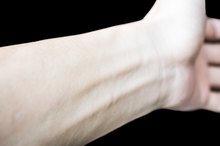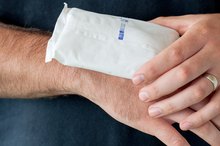Early Signs of Dry Gangrene
Dry gangrene describes localized tissue death caused by loss of blood supply. The body tissues are kept alive by a constant supply of oxygen and nutrients delivered by the blood, which also carries away tissue waste products. Inadequate blood supply due to atherosclerosis (fatty plaques in the arteries), a blood clot or trauma causes death of the affected tissues. Atherosclerosis of the arteries in the extremities is called peripheral arterial disease, or PAD. PAD is the leading cause of dry gangrene 1. Recognizing the early signs of dry gangrene and getting treatment may prevent tissue death.
If you are experiencing serious medical symptoms, seek emergency treatment immediately.
Aching Pain
Early in the process of dry gangrene, the tissues are suffering the effects of decreased oxygen and the buildup of waste products but remain alive. These circumstances commonly cause pain, which is usually dull and aching. Eventually, the pain gives way to numbness as the nerve tissues die.
Changing Skin Color
Cracked, Peeling & Itchy Skin After a Cast
Learn More
As blood supply diminishes, the skin of the affected area may appear dark red if situated below the heart. If the area is lifted to a position above the heart, it quickly blanches to an unnatural white color. When the blood supply is completely obstructed, the affected area appears pale--though it will go through a subsequent series of color changes as the dead tissue decays.
Cool Skin
An area of skin with insufficient blood supply is cool to the touch. If you put one hand on the affected area and the other on an area with normal blood supply, you can easily feel a marked temperature difference. As dry gangrene progresses and the tissue dies, the area becomes cold.
Skin Ulcers
Cold Sore Stages
Learn More
Dry gangrene is often heralded by the formation of one or more skin ulcers--crater-like wounds in the skin. The ulcers are typically painful. A black rim of dead tissue commonly surrounds the ulcer; this tissue may be the harbinger of wider tissue loss in the area. Ulcer depth is an indicator of the probability of the development of full-blown dry gangrene requiring amputation.
- Dry gangrene is often heralded by the formation of one or more skin ulcers--crater-like wounds in the skin.
Warning
If you experience any signs of dry gangrene, seek medical attention right away. Early treatment improves the chance for successful treatment of this serious condition.
Related Articles
References
- Types of Bacteria: What is Gangrene?
- National Heart, Lung and Blood Institute: Peripheral Arterial Disease
- Short Textbook of Surgery; Himansu Roy; 2010
- Li C, Zhou X, Liu LF, Qi F, Chen JB, Zu XB. Hyperbaric Oxygen Therapy as an Adjuvant Therapy for Comprehensive Treatment of Fournier's Gangrene. Urol Int. 2015;94(4):453-8. DOI: 10.1159/000366137
- Bonne SL, Kadri SS. Evaluation and Management of Necrotizing Soft Tissue Infections. Infect Dis Clin North Am. 2017;31(3):497-511. doi:10.1016/j.idc.2017.05.011
- Peripheral arterial disease in people with diabetes. Diabetes Care. 2003;26(12):3333-41. doi:10.2337/diacare.26.12.3333
- Bloomgarden ZT. Diabetic neuropathy. Diabetes Care. 2007;30(4):1027-32. doi:10.2337/dc07-zb04
- Backhaus M, Citak M, Tilkorn DJ, Meindl R, Schildhauer TA, Fehmer T. Pressure sores significantly increase the risk of developing a Fournier's gangrene in patients with spinal cord injury. Spinal Cord. 2011;49(11):1143-6. doi:10.1038/sc.2011.75
- Assadian O, Assadian A, Senekowitsch C, Makristathis A, Hagmüller G. Gas gangrene due to Clostridium perfringens in two injecting drug users in Vienna, Austria. Wien Klin Wochenschr. 2004;116(7-8):264-7. doi:
- Al wahbi A. Autoamputation of diabetic toe with dry gangrene: a myth or a fact?. Diabetes Metab Syndr Obes. 2018;11:255-264. doi:10.2147/DMSO.S164199
- Buboltz JB, Murphy-Lavoie HM. Gas Gangrene. In: StatPearls. Treasure Island (FL): StatPearls Publishing; 2019 Jan-.
- Singh A, Ahmed K, Aydin A, Khan MS, Dasgupta P. Fournier's gangrene. A clinical review. Arch Ital Urol Androl. 2016;88(3):157-164. doi:10.4081/aiua.2016.3.157
- National Health Service. Symptoms - Gangrene.
- Adigun R, Basit H, Murray J. Necrosis, Cell (Liquefactive, Coagulative, Caseous, Fat, Fibrinoid, and Gangrenous) In: StatPearls. Treasure Island (FL): StatPearls Publishing; 2019 Jan-.
- Bellapianta JM, Ljungquist K, Tobin E, Uhl R. Necrotizing fasciitis. J Am Acad Orthop Surg. 2009;17(3):174-82. doi:10.5435/00124635-200903000-00006
- Yang Z, Hu J, Qu Y, et al. Interventions for treating gas gangrene. Cochrane Database Syst Rev. 2015;(12):CD010577. doi:10.1002/14651858.CD010577.pub2
- Marineau ML, Herrington MT, Swenor KM, Eron LJ. Maggot debridement therapy in the treatment of complex diabetic wounds. Hawaii Med J. 2011;70(6):121-4.
- Bonne SL, Kadri SS. Evaluation and Management of Necrotizing Soft Tissue Infections. Infect Dis Clin North Am. 2017 Sep;31(3):497-511. DOI: 10.1016/j.idc.2017.05.011
- Li C, Zhou X, Liu LF, Qi F, Chen JB, Zu XB. Hyperbaric Oxygen Therapy as an Adjuvant Therapy for Comprehensive Treatment of Fournier's Gangrene. Urol Int. 2015;94(4):453-8. DOI: 10.1159/000366137
Writer Bio
Dr. Tina M. St. John owns and operates a health communications and consulting firm. She is also an accomplished medical writer and editor, and was formerly a senior medical officer with the U.S. Centers for Disease Control and Prevention. St. John holds an M.D. from Emory University School of Medicine.









